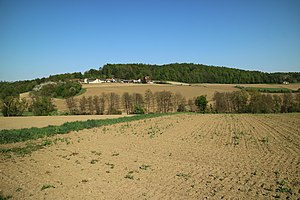Kögelberg (Eastern Styrian hill country)
| Kögelberg | ||
|---|---|---|
|
Kögelberg from the west |
||
| height | 441 m above sea level A. | |
| location | southeast of Graz, Styria | |
| Mountains | Oststeirisches Hügelland ( mountain range east of the Mur ) | |
| Coordinates | 46 ° 56 '20 " N , 15 ° 32' 46" E | |
|
|
||
| particularities | Stone Age site ( Idol vom Kögelberg ) | |
The Kögelberg ( 441 m above sea level ) is a mountain that surrounds the Graz Basin to the Eastern Styrian hill country . It is known as an archaeological site.
Location and landscape
The Kögelberg is located a good 15 kilometers southeast of the city center of Graz , not far from Kalsdorf . It is located directly above Waasen Castle in the municipality of Heiligenkreuz am Waasen , 1 km south of Ortisei . The ridge between Mur and Stiefing , which borders the Graz Basin to the southeast, ends about 5 km south. To the west goes the Grabenbergbach (Erabach) to the Mur near Neudorf, south of the Wurzingbach to the Mur near Wildon, to the east of the Götauberach to the Stiefing near Kleinfeiting. In the Erabach valley, the village of Turning is located on the western mountainside , to the north on the Turningberg ridge, and to the east, directly on the mountain, is the scattered settlement of Aschnull .
archeology
The Graz Basin and the mountains around Graz are prehistorically rich. A Neolithic settlement from the Neolithic period was found on the Kögelberg . Emergency excavations had to be carried out in 1984 due to leveling work , and the site was partially destroyed. The archaeologists Gerald Fuchs and Diether Kramer found a little head of a small human figure made of clay, the idol of Kögelberg, just a few centimeters .
According to style analyzes of the idol fragment, which is the oldest human figure found in Styria along with the Graz-iella , the settlement of the Lasinja culture can be assigned to the Middle Copper Age (Copper Age, ending Neolithic Age), which here mostly around 3700 BC. And which can also be found on the Kanzianiberg . Because of the finds at the nearby Wildoner Buchkogel , the beginning of the Copper Age from 4000 BC was also noted. Chr. (Epi- Lengyel horizon) suspected. More recent opinions put the figure close to the Middle Neolithic Vinča culture , which is believed to have been around 5400-4500 BC. Chr. Assumes.
Hike
The Grazer Umland-Weg passes through Turning directly below. The mountain itself is easily accessible on the roads.
See also
- Prehistoric settlement Farching (southwest, Laten period-pre-Roman)
literature
- Diether Kramer: The Copper Age settlement on the Kögelberg. (Article prehistory. ) In: Josef Riegler (Ed.): Heiligenkreuz am Waasen. Self-published by the municipality, 1986, p. 11.
Individual evidence
- ↑ Landesmuseum Joanneum: Annual Report 1984. New Series 14, Graz 1985, p. 108 in the section Reports: Department for Prehistory and Early History and Coin Collection. PDF on ZOBODAT there p. 112.
- ↑ G. Fuchs, D. Kramer: The Idol vom Kögelberg - the oldest human representation in Styria. In: Joanneum aktuell 1, 1985, pp. 6-7.
- ↑ Elisabeth Ruttkay: The first Neolithic idol head from Styria. To the idol sculpture of the Lasinja culture. In: Antidóron Dragoslavo Srejovic: copmletis LXV annis ab amicis collegis discipulis oblatu = Uzdarje Dragoslavu Srejoviću. Povodom šezdesetpet godina života od prijatelja, saradnika i učenika. (ed. Lazic, M.) Beograd, 1997, pp. 181-191.
- ↑ Georg Tiefengraber: Neolithic and Copper Age. In Bernhard Hebert (ed.): Prehistory and Roman times in Styria. Volume 1 of the history of Styria . Böhlau Verlag, Vienna 2015, ISBN 9783205796916 , in the section Religion and Cult , p. 212 Col. 2 f limited preview in the Google book search.

